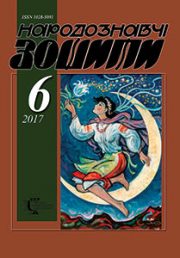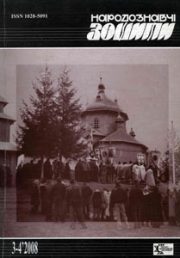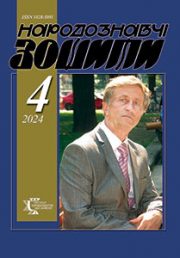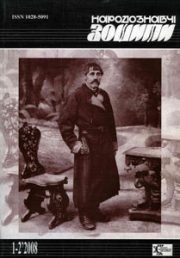The Ethnology Notebooks. 2021. # 1 (157), P. 84—97
УДК [[008(=161.2):17.035.3]:[061.2-053.67:796]](477.83-22)”1925/1939″”Луг”
DOI https://doi.org/10.15407/nz2021.01.084
Маrіa HORBAL
- ORCID ID: https://orcid.org/0000-0001-9287-8336
- leading scientific editor,
- The Institute of Ethnology of the National
- Academy of Sciences of Ukraine,
- 15, Svobody Avenue, 79000, Lviv, Ukraine,
- e-mail: horbal.m@gmail.com
«LUH» ІN SELYSKO VILLAGE OF LVIV REGION (FIRST HALF OF XX CENTURY)
Problem statement. As a result of ZUNR (Western Ukrainian People’s Republic) defeat in Polish-Ukrainian war of 1918—1919, Galizia ended up under the Second Polish Republic (Rzeczpospolita Polska). According to the resolution of the Council of representatives of the winner-states dated November 21st, 1919, Galizia was given to Poland for 25 years.
During an interwar period, Ukraine has been under extremely difficult socio-economical and political circumstances — the destruction of Ukrainian identity by Polish authorities. For the sake of maintaining of Ukrainian nation, social spiritual and patriotic potential has been activated. As a need to preserve Ukrainian ethnicity arose, a key goal has been set — to bring up a new generation of patriotic youth. This became a task of «Luh» organization. This community has been aiming at the athletic and patriotic upbringing of young people for the future wrestle for Ukrainian state.
This topic is to this day still relevant on the scales of history. «Luh» society in Galizia was one of the biggest legal youth firefighting and sports organizations, established in 1925 and prohibited by the Soviet regime in 1939. The goal of our research is to study — on the background of «Luh» activity in all of Galizia — «Luh’s» role in one village, Selysko, in Lviv region, Pustomyty district.
Thus, the object of our study is «Luh» in Selysko village and the subject matter — the structure and functioning of «Luh» society. The resourcesour article is based on, are: «News from Luh», a newsletter that the society had been publishing during the 1926—1939 period in Lviv; records of the respondents from Selysko village, as well as materials from the archive.
Conclusions. After analyzing the functioning of «Luh» society in one village — Selysko of Lviv region, in Pustomyty district — we may conclude that «Luh» had a great potential that could guarantee, though in the conditions of the destruction of Ukrainian identity by Polish authorities, a national cultural revival of Ukrainians and their spiritual values. The goal of the society was to form the priorities and main directions of patriotic upbringing of the youth, based on national and patriotic worldview, preservation and cultivation of spiritual values of Ukrainian people and, eventually — formation of national and cultural identity.
Keywords: Galizia, Selysko village, «Luh», firefighting sports society, 1925—1939, «National house» (library and reading hall), «News from Luh», spiritual values of society, calendar ceremonials and traditions, history and life of the nation.
REFERENCES
- Semchishin, M. (1993). Thousands of years of Ukrainian culture. Historical overview of the cultural process. 2nd type. Kyiv [in Ukrainian].
- (1939). Luh calendar. Lviv [in Ukrainian].
- (1929). Luh evening in Lviv. News from Luh. Lviv. April. № 4 [in Ukrainian].
- (1934). Kurdidyk, A. What does Luh do?News from Luh. Lviv. January. № 1 [in Ukrainian].
- (1929). Zharsky, E. Athletics. News from Luh. Lviv. April. № 4 [in Ukrainian].
- (1926). Bow to the Great Teacher. Luh holiday in Lviv. News from Luh. Lviv. July. № 1 [in Ukrainian].
- (1926). Bow to the Great Teacher. Holiday of Ivan Franko in Bibrka. News from Luh. Lviv. July. № 1 [in Ukrainian].
- (1929). Luh holy in Lviv. News from Luh. Lviv. July. № 7 [in Ukrainian].
- (1929). Luh holy Festini — Census. News from Luh. Lviv. May. № 5 [in Ukrainian].
- (1926). News from Luh. Lviv. July 25 [in Ukrainian].
- (1929). You can’t pass Seliskо. News from Luh. Lviv. December. № 12 [in Ukrainian].
- (1929). Fire in Milyatychi, pov. Lviv. News from Luh. Lviv. October. № 10 [in Ukrainian].
- (1929). «Luhs» as fire guards. News from Luh. Lviv. August. № 8 [in Ukrainian].
- (1929). Read books together. News from Luh. Lviv. October. № 10 [in Ukrainian].
- (1929). Selisko, Lviv district. News from Luh. Lviv. July. № 7 [in Ukrainian].
- Comisаr, I. (2000). Formation of the Ukrainian national school in Galicia (1920—1939). The liberation path. Vol. 1 (622) [in Ukrainian].
- (1933). What to do Luhs on Holidays. News from Luh. Lviv. December. № 12 [in Ukrainian].
- Kravchenko, U. (1931). Hey, entice, Lug calls us. News from Luh. Lviv. July. № 7 [in Ukrainian].
- (1929). Work plan. News from Luh. Lviv. October. № 10 [in Ukrainian].
- Census of population and its property Selisko village, Lviv region as of 1940—1941 and 1950 (2020). Ethnographic notebooks (№ 4. Рр. 974—1009) [in Ukrainian].
- (1930). A holiday in honor of Frankо in Bibrka. News from Luh. Lviv. August. № 8 [in Ukrainian].
- (1932). Luh holiday in Lviv. June 26. News from Luh. Lviv. July. № 7 [in Ukrainian].
- (1933). From the life of Luhs. Seliska, pov. Lviv. News from Luh. Lviv. June. № 6 [in Ukrainian].
- (1934). From the life of Luhs. Seliska, pov. Lviv. News from Luh. Lviv. February—March. № 2—3 [in Ukrainian].
- (1934). From the life of Luhs. Seliska, pov. Lviv. News from Luh. Lviv. June. № 6 [in Ukrainian].
- (1929). We are erecting monuments to fallen soldiers. News from Luh. Lviv. October. № 10 [in Ukrainian].
- Melʹnyk, N. (2020). My Lopushna. Lviv [in Ukrainian].
- (1937). Second General Congress. News from Luh. Lviv. September. № 9 [in Ukrainian].
- (1937). Military training of school youth. News from Luh. Lviv. September. № 10 [in Ukrainian].







